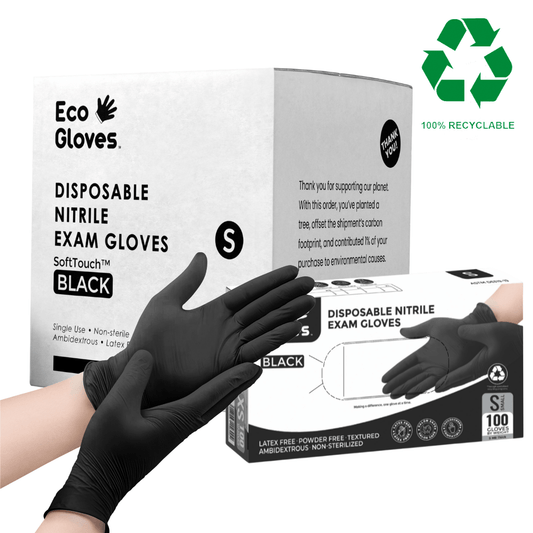Balancing Care and Safety: The Importance of Proper Glove Use in Home Care Settings
Eco GlovesIn home care services, where kindness and skill go hand in hand, keeping both caregivers and those they help safe is the most important thing. One important part of staying safe that people often forget is using gloves correctly. When used correctly, gloves help protect both the caregiver and the patient from germs and infections. In this article we will discuss why using gloves is important in home care, different kinds of gloves, how to use them safely, and what might happen if we don’t use them when we should.
Topics Covered
- Understanding the Risks
- The Role of Gloves
- Types of Gloves
-
When to Wear Gloves
- Proper Glove Use
- Consequences of Improper Glove Use
- Hand Hygiene
- Disposable vs. Reusable Gloves
- Allergy Considerations
-
Training and Education
- Key Takeaways: Proper Glove Use in Home Care
- Frequently Asked Questions
Understanding the Risks
Home care settings can have many potential dangers. Caregivers face many health risks, including catching diseases like the flu and COVID-19, as well as coming into contact with bodily fluids and dangerous chemicals. These risks are especially high for people with weakened immune systems, ongoing health issues, or those receiving medical treatment.
The Role of Gloves
Gloves are important for protecting against these dangers. Wearing gloves can help stop the spread of germs and diseases by keeping the caregiver's hands away from harmful substances. This is very important when caregivers are dealing with dirty sheets, bodily fluids, or surfaces that may be unclean.
Types of Gloves
The type of glove you choose depends on what you need to do. Here are some usual types of gloves used at home:
- Latex Gloves: People like these because they are sensitive and easy to use. It's important to remember that some people might be allergic to latex.
- Nitrile Gloves: Nitrile gloves are a great choice for people who are allergic to latex. They provide similar safety as latex gloves but can handle chemicals better.
- Vinyl Gloves: Vinyl gloves are cheap, but they might not be as strong or able to protect against chemicals like latex or nitrile gloves.
- Utility Gloves: These gloves are made for tough jobs, like cleaning or working in the garden. They are usually made of stronger materials like rubber or leather.
When to Wear Gloves
It’s important to know when to put on gloves to stay as safe as possible. Here are some basic rules:
- When handling bodily fluids: This means blood, pee, poop, and vomit.
- When cleaning dirty areas: This means washing soiled sheets, cleaning medical tools, and cleaning places that might have touched body fluids.
-
When dealing with dangerous chemicals: This includes cleaning products, disinfectants, and other substances that can hurt or irritate the skin.
Proper Glove Use
To be most effective, gloves should be used properly. Here are some easy steps to follow:
- Check for damage: Before putting on gloves, look for any rips or holes.
- Wear the right size: Gloves that are too tight or too big can be uncomfortable and might not keep you safe.
- Don't touch dirty surfaces with your bare hands: After you put on gloves, make sure not to use your bare hands on any dirty surfaces.
- Remove gloves properly: When you take off gloves, don't touch the outside of the gloves with your bare hands.
- Dispose of gloves properly: After using them, put the gloves in the right trash can.
Consequences of Improper Glove Use
Not wearing gloves or wearing them the wrong way can lead to big problems. This can involve:
- Spread of infectious diseases: Using gloves incorrectly can raise the risk of passing on infections to both the caregivers and the people they are helping.
- Skin irritation or damage: Coming into contact with certain chemicals or irritants can cause skin issues, like rashes or blisters.
- Legal issues: Sometimes, not following the right infection control procedures can lead to legal problems.
Hand Hygiene
Even if you wear gloves, it's still important to keep in mind proper glove donning and removal practice as well as hand hygiene protocols. Wash your hands with soap and water before you put on gloves. After taking off your gloves, wash your hands again to get rid of any leftover dirt.
Disposable vs. Reusable Gloves
Choosing between disposable and reusable gloves depends on the job you're doing and how much risk there is. People usually suggest using disposable gloves when you are working with body fluids, chemicals, or other solutions or messes that cannot be easily cleaned off gloves. You can use reusable gloves for non-contaminating jobs, like dishwashing, handiwork, or light cleaning, but you need to clean and disinfect them well after each time you use them.
Allergy Considerations
Some people might be allergic to latex or other types of gloves. If you have allergic reactions to gloves, talk to a doctor to find out what other options you can use.
Training and Education
It’s important to make sure that caregivers know how to use gloves properly. This includes teaching about the different kinds of gloves, when to use them, and how to take them off safely.
Conclusion
In the fast-changing home care services, using gloves correctly is very important for keeping both caregivers and the people they help safe and healthy. By learning about the different types of gloves, when to use them, and how to use them correctly, caregivers can lower the chances of spreading infections and keep themselves safe from dangers. Using gloves is not just about following rules; it's about making sure we give the best care safely and responsibly.
Key Takeaways: Proper Glove Use in Home Care
- Gloves protect both caregivers and patients from infectious diseases, chemicals, and other hazards.
- Nitrile gloves offer strong chemical resistance and are latex-free, while latex gloves provide high sensitivity but may cause allergies.
- Gloves should always be worn when handling bodily fluids, cleaning contaminated areas, or working with hazardous chemicals.
- Proper glove use includes choosing the right size, checking for damage, correct donning and removal, and safe disposal.
- Hand hygiene before and after glove use is essential to prevent contamination.
- Training caregivers in glove types, use, and disposal ensures higher safety and compliance in home care.
👉 Shop Eco Gloves’ healthcare-ready gloves for reliable protection, comfort, and eco-conscious options for home care providers.
Frequently Asked Questions
-
Which gloves are best for home care?
Nitrile gloves are ideal—they’re durable, latex-free, and resistant to chemicals and punctures.
-
When should gloves be worn in home care?
When handling bodily fluids, cleaning soiled areas, or using potentially harmful chemicals.
-
Can reusable gloves be used in caregiving?
Only for non-contaminating tasks—disposable gloves are best for patient care or hazardous exposure.
-
How should gloves be removed to avoid contamination?
Peel gloves off from the wrist, avoiding skin contact with the contaminated exterior, and dispose of them immediately.
-
Is handwashing necessary after removing gloves?
Yes—washing hands removes any contaminants that may have bypassed or transferred during glove removal.
-
How can caregivers avoid latex allergies?
Choose nitrile or vinyl gloves as hypoallergenic alternatives.
Further Reading
- What Makes Biodegradable Nitrile Gloves More Sustainable or Eco-Friendly?
- Biodegradable Disposable Gloves: A Step Towards Sustainability in Industrial Workplaces
- A Guide to Disposable Gloves for the Workplace


















